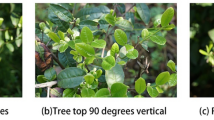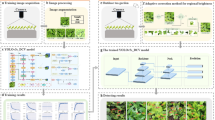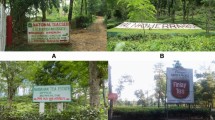Abstract
The tea industry occupies a pivotal and important position in China’s import and export trade commodities. With the improvement of people's quality of life, the demand for famous tea sprout is increasing. However, manual picking is inefficient and costly. Although mechanical picking can pick tea sprouts efficiently, it lacks selectivity, which leads to an increase in the workload of post-processing and screening of superior tea leaves. To address this, this paper establishes a dataset for tea sprouts in natural environments and proposes an improved YOLOX tea sprouts detection model, YOLOX-ST based on the Swin Transformer. The model employs the Swin Transformer as the backbone network to enhance overall detection accuracy. Additionally, it introduces the CBAM attention mechanism to address issues of miss-detection and false detections in complex environments. Furthermore, a small target detection layer is also incorporated to resolve the problem of incomplete information about tea sprout features learned from the deep feature map. To address the sample imbalance, we introduce the EIoU loss function and apply Focal Loss to the confidence level. The experimental results demonstrate that the proposed model in this paper achieves an accuracy of 95.45%, which is 5.73% higher than the original YOLOX model. Moreover, it outperforms other YOLO series models in terms of accuracy, while achieving a faster detection speed, reaching 93.2 FPS.











Similar content being viewed by others
Data availability
The data supporting this study’s findings are available from the corresponding author upon reasonable request.
References
Cao ML, Fu H, Zhu JY, Cai CG (2022) Lightweight tea bud recognition network integrating GhostNet and YOLOv5. Math Biosci Eng MBE 19(12):12897–12914. https://doi.org/10.3934/mbe.2022602
Chen B, Yan JL, Wang K, Matušů R (2021) Fresh tea sprouts detection via image enhancement and fusion SSD. J Control Sci Eng 2021:1–11. https://doi.org/10.1155/2021/6614672
Chen CL, Lu JZ, Zhou MC, Yi J, Liao M, Gao ZM (2022) A YOLOv3-based computer vision system for identification of tea buds and the picking point. Comput Electron Agric 198:107116. https://doi.org/10.1016/j.compag.2022.107116
Cortes C, Vapnik V (1995) Support-vector networks. J Mach Ing 20:273–297. https://doi.org/10.1007/BF00994018
Devlin J, Chang MW, Lee K, Toutanova K (2019) BERT: pre-training of deep bidirectional transformers for language understanding. Preprint https://doi.org/10.48550/arXiv.1810.04805
Dosovitskiy A, Beyer L, Kolesnikov A, Weissenborn D, Zhai XH, Unterthiner T, Dehghani M, Minderer M, Heigold G, Gelly S, Uszkoreit N, Houlsby, N (2021) An image is worth 16 × 16 words: transformers for image recognition at scale. Preprint http://arxiv.org/abs/2010.11929
Fu HX, Song GP, Wang YC (2021) Improved YOLOv4 marine target detection combined with CBAM. Symmetry 13(4):623. https://doi.org/10.3390/sym13040623
Girshick R (2015) Fast R-CNN. In: Proceedings of the IEEE international conference on computer vision, pp 1440–1448
Girshick R, Donahue J, Darrell T, Malik J (2014) Rich feature hierarchie for accurate object detection and semantic segmentation. In: Proceedings of the IEEE conference on computer vision and pattern recognition, pp 580–587
Gui ZY, Chen JN, Li Y, Chen ZW, Wu CY, Dong CW (2023) A lightweight tea bud detection model based on Yolov5. Comput Electron Agric 205:107636. https://doi.org/10.1016/j.compag.2023.107636
Jian W, Li SG, Yang C (2019) Fast segmentation of tea flowers based on color and region growth. In: 11th international conference on digital image processing (ICDIP 2019), pp 111790R. https://doi.org/10.1117/12.2539682
Karunasena GMKB, Priyankara H (2020) Tea bud leaf identification by using machine learning and image processing techniques. Int J Sci Eng Res 11(8):624–628. https://doi.org/10.14299/ijser.2020.08.02
Lin TY, Goyal P, Girshick R, He KM, Dollár P (2017a) Focal loss for dense object detection. In: 2017 IEEE international conference on computer vision (ICCV), pp 2999–3007. https://doi.org/10.1109/ICCV.2017.324
Lin TY, Dollár P, Girshick R, He KM, Hariharan B, Belongie S (2017b) Feature pyramid networks for object detection. In: 2017 IEEE conference on computer vision and pattern recognition (CVPR), pp 936–944. https://doi.org/10.1109/CVPR.2017.106
Lin TY, Goyal P, Girshick R, He KM, Dollár P (2017) Focal loss for dense object detection. In: 2017 IEEE international conference on compute vision (ICCV), pp 2999–3007. https://doi.org/10.1109/ICCV.2017.324
Liu W, Anguelov D, Erhan D, Szegedy C, Reed S, Fu CY, Berg AC, Leibe B, Matas J, Sebe N, Welling M (2016) SSD: single shot multibox detector. In: Computer vision—ECCV 2016, lecture notes in computer science, pp 21–37. https://doi.org/10.1007/978-3-319-46448-0_2
Liu Z, Lin YT, Cao Y, Hu H, Wei YX, Zhang Z, Lin S, Guo B (2021) Swin Transformer: hierarchical vision transformer using shifted windows. In: 2021 IEEE/CVF international conference on computer vision (ICCV), pp 9992–10002. https://doi.org/10.1109/ICCV48922.2021.00986
Ma B, Wang XR, Zhang H, Li Fu, Dan JW, Sun XM, Pan ZQ, Bertino E (2019) CBAM-GAN: generative adversarial networks based on convolutional block attention module. In: Artificial intelligence and security, pp 227–236. https://doi.org/10.1007/978-3-030-24274-9_20
Paranavithana IR, Kalansuriya VR (2021) Deep convolutional neural network model for tea bud(s) classification. IAENG Int J Comput Sci 48(3):599–604
Redmon J, Farhadi A (2016) YOLO9000: better, faster, stronger. computer vision and pattern recognition. Preprint https://doi.org/10.48550/arXiv.1612.08242
Redmon J, Farhadi A (2018) YOLOv3: an incremental improvement. computer vision and pattern recognition. Preprint. https://doi.org/10.48550/arXiv.1804.02767
Redmon J, Divvala S, Girshick R, Farhadi A (2016) You only look once: unified, real-time object detection. In: Proceedings of the IEEE conference on computer vision and pattern recognition, pp 779–788
Ren SQ, He KM, Girshick R, Sun J (2015) Faster R-CNN: towards real-time object detection with region proposal networks. In: Advances in neural information processing systems, pp 28
Rezatofighi H, Tsoi N, Gwak J, Sadeghian A, Reid L, Savarese S (2019) Generalized intersection over union: a metric and a loss for bounding box regression. Preprint http://arxiv.org/abs/1902.09630
Shao PD, Wu MH, Wang XW, Zhou J, Liu S (2018) Research on the tea bud recognition based on improved k-means algorithm. In: Proceedings of 2018 2nd international conference on electronic information technology and computer engineering (EITCE 2018), pp 846–850
Wang CY, Bochkovskiy A, Liao HYM (2023) YOLOv7: trainable bag-of-freebies sets new state-of-the-art for real-time object detectors. In: 2023 IEEE/CVF conference on computer vision and pattern recognition (CVPR), pp 7464–7475. https://doi.org/10.1109/CVPR52729.2023.00721
Woo SH, Park JC, Lee JY, Kweon IS (2018) CBAM: convolutional block attention module. Preprint http://arxiv.org/abs/1807.06521
Xu WK, Zhao LG, Li J, Shang SQ, Ding XP, Wang TW (2022) Detection and classification of tea buds based on deep learning. Comput Electron Agric 192:106547. https://doi.org/10.1016/j.compag.2021.106547
Yang HL, Chen L, Chen MT, Ma ZB, Deng F, Li MZ, Li XR (2019) Tender tea shoots recognition and positioning for picking robot using improved YOLO-V3 model. IEEE Access 7:180998–181011. https://doi.org/10.1109/ACCESS.2019.2958614
Zhang L, Zou L, Wu CY, Jia JM, Chen JN (2021a) Method of famous tea sprout identification and segmentation based on improved watershed algorithm. Comput Electron Agric 184:106108. https://doi.org/10.1016/j.compag.2021.106108
Zhang G, Liu ST, Wang F, Li ZM, Sun J (2021b) YOLOX: exceeding YOLO series in 2021. Preprint. https://doi.org/10.48550/arXiv.2107.08430
Zhang YF, Ren WQ, Zhang Z, Jia Z, Wang L, Tan T (2022) Focal and efficient IOU loss for accurate bounding box regression. Neurocomputing 506:146–157. https://doi.org/10.1016/j.neucom.2022.07.04
Acknowledgements
This work was supported by National Key Research and Development Program (No. 2016YFD0201305-07), Guizhou Provincial Basic Research Program (Natural Science) (No. ZK[2023]060), Open Fund Project in Semiconductor Power Device Reliability Engineering Center of Ministry of Education (No. ERCMEKFJJ2019-06). Thanks for the computing support of the State Key Laboratory of Public Big Data, Guizhou University.
Author information
Authors and Affiliations
Corresponding author
Ethics declarations
Conflict of interest
The authors declared no potential conflict of interest with respect to the research, author-ship, or publication of this article.
Additional information
Publisher's Note
Springer Nature remains neutral with regard to jurisdictional claims in published maps and institutional affiliations.
Rights and permissions
Springer Nature or its licensor (e.g. a society or other partner) holds exclusive rights to this article under a publishing agreement with the author(s) or other rightsholder(s); author self-archiving of the accepted manuscript version of this article is solely governed by the terms of such publishing agreement and applicable law.
About this article
Cite this article
Li, X., Liu, R., Li, Y. et al. An improved model based on YOLOX for detection of tea sprouts in natural environment. Evolving Systems (2024). https://doi.org/10.1007/s12530-024-09589-2
Received:
Accepted:
Published:
DOI: https://doi.org/10.1007/s12530-024-09589-2




